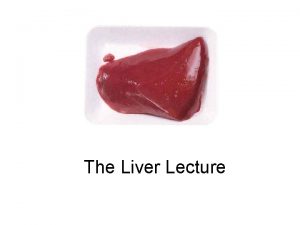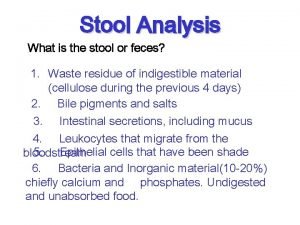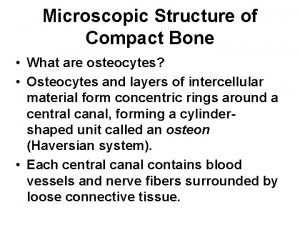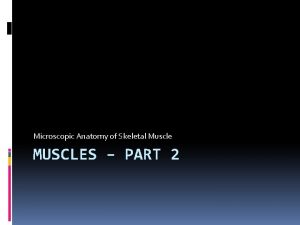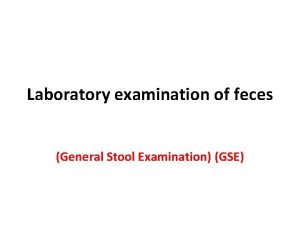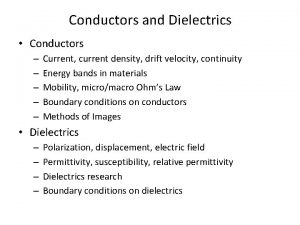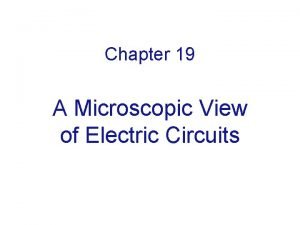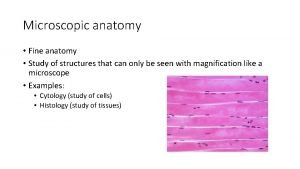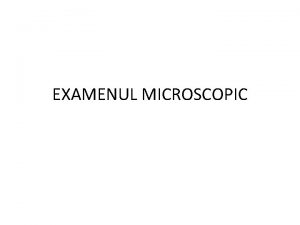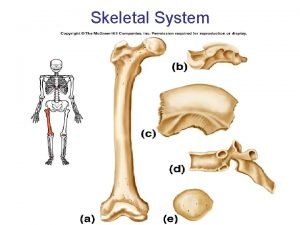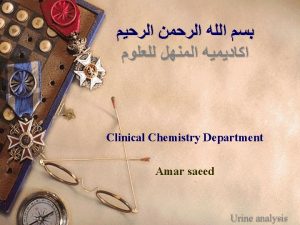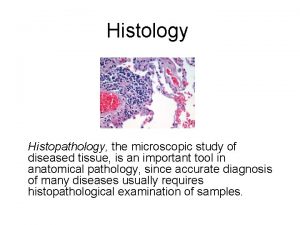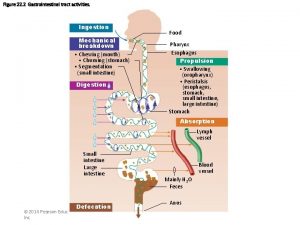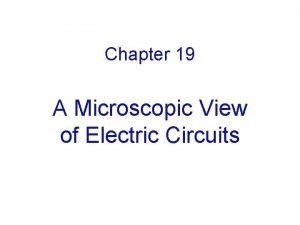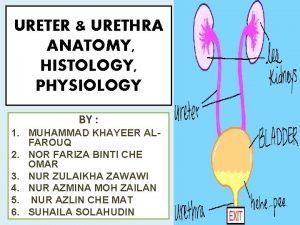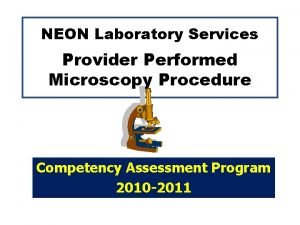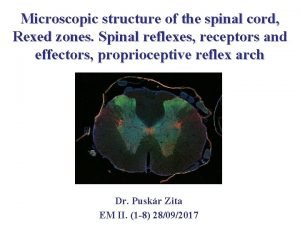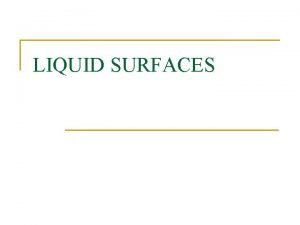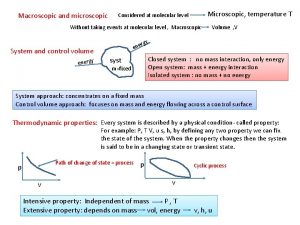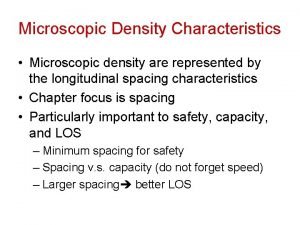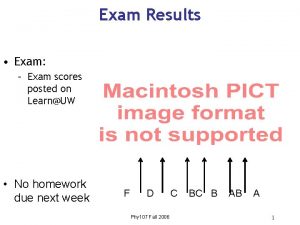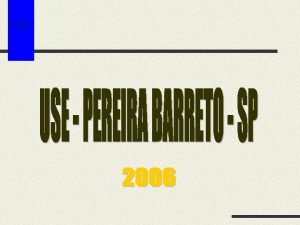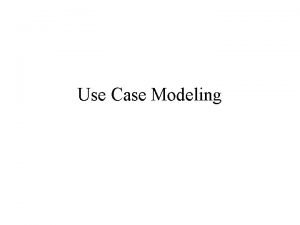UA Microscopic Exam UA Microscopic Exam Use a










































- Slides: 42

UA Microscopic Exam

UA Microscopic Exam • Use a well mixed urine specimen • Pour about 10 m. L into a labeled centrifuge tube and cap. • Place specimen in centrifuge; be sure the tube is balanced by another tube in centrifuge. • Secure the lid and spin for 5 minutes.

UA Microscopic Exam • Remove the tube from the centrifuge after the instrument as come to full stop. • Pour off the clear supernatant from the top of the specimen by inverting the tube over the sink drain. DO NOT TURN THE TUBE UPRIGHT UNTIL THE SUPERNATANT HAS BEEN FULLY DECANTED.

UA Microscopic Exam Sediment remaining in the tube will be examined under the microscope

UA Microscopic Exam • Thoroughly mix the sediment by grasping the tube near the top and rapidly flicking it with the fingers of the other hand until all sediment is thoroughly resuspended. • Transfer one drop of sediment to a clean, labeled slide using a clean, disposable transfer pipette.

UA Microscopic Exam • Transfer one drop of sediment to a clean, labeled slide using a clean, disposable transfer pipette. • Place a clean coverslip over the drop and place the slide on the microscope stage. The remaining steps are usually performed by healthcare practitioner. Medical Assistants should not perform the microscopic exam unless specifically trained.

UA Microscopic Exam • Casts: – Formed when protein accumulates and precipitates in the kidney tubules and is washed into the urine. – Protein takes on size and shape of the tubules. – Cylindric , with flat or rounded ends, and are classified according to the substances observed in them. – Certain types are associated with renal pathologic conditions others are physiologic and are generally caused by strenuous exercise.

UA Microscopic Exam • Casts: – Are counted and reported under low-power magnification: occasionally high-power magnification is needed to identify the type. – Closely examine edges of coverslip – Sediment may be stained with a supravital stain to give greater contrast to formed elements……Most common is Sternheimer-Malbin stain consisting of crystal violet and safranin…. ”Sedistain”.

UA Microscopic Exam • Focus under low power and reduce the light. • First scan the entire coverslip for abnormal findings. • Examine at least 5 low-power fields. – Count and classify each type of cast seen, if any. Hyaline casts: are pale transparent, cylindric and have rounded ends and parallel sides. Missed if light not reduced at the condenser.

UA Microscopic Exam Cast formation in renal tubules.

• Hyaline casts: – Formed when urine flow through individual nephrons is diminished. – Also can be found in urine of individuals with kidney disease but also in the urine of people without such disease who have exercised heavily. – Occasionally hyaline casts have granular or cellular inclusions.

UA Microscopic Exam Cellular casts most commonly result when disease processes such as ischemia, infarction, or nephrotoxicity cause degeneration and necrosis of tubular epithelial cells. The presence of these casts indicates acute tubular injury but does not indicate the extent or reversibility of the injury. White blood cell casts are hyaline casts that contain leukocytes. . Usually seen in pyelonephritis. WBC are multilobed whereas renal tubular cells are single round nucleus.

UA Microscopic Exam Granular casts, as the name implies, have a textured appearance which ranges from fine to coarse in character. Finely and coarsely granular casts may be caused by exercise, but the presence of increased numbers may indicate renal disease.

UA Microscopic Exam Fatty casts are identified by the presence of refractile lipid droplets. The background matrix of the cast may be hyaline or granular in nature. Often, they are seen in urines in which free lipid droplets are present as well. Fatty casts are the most common type seen in cat urines. Interpretation of the significance of "fatty" casts should be based on the character of the cast matrix, rather than on the lipid content per se.

UA Microscopic Exam Waxy casts have a smooth consistency but are more refractile and therefore easier to see compared to hyaline casts. They commonly have squared off ends, as if brittle and easily broken. Waxy casts indicate tubular injury of a more chronic nature than granular or cellular casts and are always of pathologic significance.

UA Microscopic Exam • Red Blood Cell Casts Hyaline casts with embedded red cells. Their presence indicates damage to the glomerular membrane. They may appear brown as a result of the color of the red blood cells.

UA Microscopic Exam • Renal tubular epithelial cells: Easily confused with WBC casts especially if cells have started to degenerate. Renal tubular epithelial cell casts are found when excessive damage has occurred. Causes are shock, renal ischemia, heavymetal poisoning; certain allergic reactions and nephrotoxic drugs.

UA Microscopic Exam • Switch to high-power magnification and adjust the light. • Other sediment findings include: – Cells – Crystals – Micro-organisms; fungus

UA Microscopic Exam • Cells: – Include: epithelial cells derived from the lining of the genitourinary tract; red blood cells and white blood cells from the bloodstream. – Cells are classified and counted under high-power magnification. – RBCs may enter the urinary tract at any point of inflammation or injury. May be found in normal urine in small numbers 1 – 2 per high-power field.

UA Microscopic Exam • RBCs: – RBCs are pale, round, nongranular, and flat or biconcave. – Smaller than WBCs and have no nucleus. – In hypotonic (dilute) urine they swell and burst. – In hypertonic (concentrated) may crenate and wrinkle. – May be confused with yeast, oil droplets, and droplets of lens cleaner.

UA Microscopic Exam Hematuria: Presence of RBCs

UA Microscopic Exam • WBCs (Leukocytes) – May be found in normal urine; increased numbers (more than 5 cells per high-power field) associated with inflammation or contamination. – Larger than RBCs and have a granular appearance and usually multilobed nucleus; usually neutrophils.

UA Microscopic Exam • WBCs Most WBCs in urine are Neutrophils. Not to be confused with Renal tubular or round epithelial cells.

UA Microscopic Exam • Renal tubular or round epithelial cells: – Larger than WBCs – Round or oval – Nucleus that is single, large, oval and sometimes eccentric. – Few may be found in normal urine but their presence is increased numbers indicates tubular damage.

UA Microscopic Exam Renal Tubular Epithelial Cells

UA Microscopic Exam • Transitional Epithelial Cells: Transitional epithelial cells originate from the renal pelvis, ureters, urinary bladder and/or urethra. Their size and shape depends on the depth of origin in the mucosa. Most often they are round or polygonal; less commonly pear-shaped, tailed, or spindle-shaped. They are generally somewhat smaller and smoother in outline than squamous cells, but larger than WBC. They may develop refractile, fatty inclusions as they degenerate in older specimens.

UA Microscopic Exam • Squamous Epithelial Cells: – In the lower portion of the genitourinary tract. – Present in large numbers in female patients usually indicates vaginal contamination. – Squamous epithelial cells are large, flat irregular cells and are easily recognized under low-power. – Have a single, small, round, centrally located nucleus and often occur in sheets or clumps. – Edges of the cells are often rolled or folded.

UA Microscopic Exam • Squamous epithelial cells Identifying epithelial cells: helpful to remember the appearance of eggs; round epithelial cells resemble hard-boiled eggs that have been cut in half. Transitional forms resemble poached eggs and squamous cells resemble fried eggs with large, runny whites.

UA Microscopic Exam • Crystals: – Are common in urine specimens, particularly if the specimen has been allowed to cool. • Cooling causes the solid crystals to precipitate out of the urine. – Usually not clinically significant unless found in large numbers. – Abnormal crystals are seen in acidic urine. • May be metabolic in origin • Present because of certain disease states or inherited metabolic conditions.

UA Microscopic Exam • Crystals: – Abnormal crystals: • May be of iatrogenic (of or relating to illness caused by medical examination or treatment) origin and are present as a result of medication or treatment.

UA Microscopic Exam • Identification of Crystals: – Begins with determination of the p. H of the urine to ascertain whether the sample is acidic or alkaline. – Next Color, shape and refractivity observed. • Use of phase or polarized microscope or using supravital stain can assist in ID • History of medication intake and recent diagnostic testing. – Crystals are identified with lo-power and high-power lenses and their presence is reported as occasional, few, moderate or many per HPF

UA Microscopic Exam • Crystals: – Amorphous • Amorphous urates are salts of uric acid and are seen as shapeless granulation in acidic urine. • Amorphous phosphates are found in alkaline urine and are seen as fluffy white precipitate. • Profuse and can obscure other formed elements in the sediment. • Frequently are difficult to identify without additional chemical testing, such as solubility testing in acid and base.

UA Microscopic Exam • Amorphous Crystals: Amorphous phosphates alkaline urine Amorphous urates acidic urine

UA Microscopic UA • Normal Crystals acid urine. Calcium oxalate crystals Uric acid crystals

UA Microscopic Exam • Normal Crystals Alkaline urine Ammonium biurate crystals; yellow brown “thorny apples” Will convert to uric acid when acetic acid is added. Triple phosphate crystals

UA Microscopic Exam • Abnormal Crystals: Sulfonamide crystals Cholesterol crystals.

UA Microscopic Exam • Miscellaneous findings: – Oval fat bodies: formed when renal tubular epithelial cells or macrophages absorb fats. • Vary in size and are refractive. • Characteristic of nephrotic syndrome and distinguished by using Sudan III stain – Yeast: May indicate vaginal contamination or infection of the urine with yeast. • Common in urine of diabetics • Can be confused with RBCs; usually are oval and show budding.

UA Microscopic Exam • Miscellaneous Findings: – Bacteria: A few present may be normal. Heavy bacterial concentrations in the absence of WBC may indicate that the specimen was allowed to sit at RT and bacteria multiplied. • Specimens with a putrid odor and numerous WBCs and bacteria are common with UTIs. • May be bacilli (rod shaped) or cocci (spheric) • Often motile and can be identified under low and high power.

UA Microscopic Exam • Miscellaneous Findings Urine contaminant fiber Fecal parasites Fecal material, including eggs of intestinal parasites, sometimes contaminates voided urine samples.

UA Microscopic Exam • Miscellaneous Findings: Yeast; Candida Bacterial Infection

UA Microscopic Exam • Parasites: Most common Trichomonas vaginalis

The End
 Microscopic anatomy of liver
Microscopic anatomy of liver Stool analysis
Stool analysis Art labeling activity figure 23.5
Art labeling activity figure 23.5 Microscopic anatomy of compact bone
Microscopic anatomy of compact bone Microscopic anatomy of skeletal muscles
Microscopic anatomy of skeletal muscles Microscopic organism definition
Microscopic organism definition Gse test
Gse test Impediment to responsibility
Impediment to responsibility Resistivity
Resistivity Ohm's law microscopic form
Ohm's law microscopic form Heat is simply another word for
Heat is simply another word for Chemstix urinalysis data sheet answers
Chemstix urinalysis data sheet answers Is nichrome an ohmic resistor
Is nichrome an ohmic resistor Glioblastoma multiforme
Glioblastoma multiforme Water expansion temperature graph
Water expansion temperature graph Microscopic anatomy of skeletal muscle figure 6-2
Microscopic anatomy of skeletal muscle figure 6-2 Microscopic anatomy of skeletal muscle figure 6-2
Microscopic anatomy of skeletal muscle figure 6-2 Where a computer keeps data, instructions, and information
Where a computer keeps data, instructions, and information Example of microscopic anatomy
Example of microscopic anatomy Microscopic examination of metals
Microscopic examination of metals Coloratia gram etape
Coloratia gram etape Father of microscopic forensics
Father of microscopic forensics Biological productivity examples
Biological productivity examples Diagram microscopic structure of bone
Diagram microscopic structure of bone Evaluasi mutu simplisia
Evaluasi mutu simplisia Compact bone
Compact bone Direct microscopic count
Direct microscopic count Histopathology is a subdiscipline of microscopic anatomy.
Histopathology is a subdiscipline of microscopic anatomy. Microscopic anatomy of skeletal muscle
Microscopic anatomy of skeletal muscle Microscopic transistor
Microscopic transistor Urine analysis
Urine analysis The microscopic study of diseased tissue.
The microscopic study of diseased tissue. Transverse mesocolon
Transverse mesocolon Microscopic view of current
Microscopic view of current Functions of urethra
Functions of urethra Microscopic procedures for primary care providers
Microscopic procedures for primary care providers Rexed laminae
Rexed laminae Microscopic energy
Microscopic energy Laplace pressure
Laplace pressure Microscopic single celled prokaryotes
Microscopic single celled prokaryotes Correctly label the following parts of the digestive system
Correctly label the following parts of the digestive system Casts in urine
Casts in urine Perichondrium
Perichondrium
